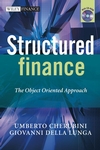Structured Finance: The Object Oriented ApproachISBN: 978-0-470-02638-0
Hardcover
298 pages
June 2007
 This is a Print-on-Demand title. It will be printed specifically to fill your order. Please allow an additional 10-15 days delivery time. The book is not returnable.
|
||||||
Structured Finance: The Object Orientated Approach is aimed
at both the finance and IT professionals involved in the structured
finance business with the intention of sharing common concepts and
language within the industry. The financial community (structurers,
pricers and risk managers) view structured products as collections
of objects under the so-called replicating portfolio paradigm. The
IT community use object oriented programming (OOP) techniques to
improve the software updating and maintenance process. For them
structured products are collections of objects as well. Despite use
of the same object concept, it looks like communication
between these different professional functions has been
problematic. Recently, construction of standard data structures
known as FpML has begun to lay out a common definition of objects,
at least for plain vanilla derivatives, both between IT and
financial people and across different market players. Along this
line, this book builds upon the concept of object to provide
frontier treatment of structured finance issues relevant to both
communities engaged in building, pricing and hedging products and
people engaged in designing and up-dating the corresponding
software.
Structured Finance: The Object Orientated Approach will enable you to:
- decompose a structured product in elementary constituent financial objects and risk factors (replicating portfolio)
- understand the basics of object oriented programming (OOP) applied to the design of structured cash flows objects
- build your own objects and to understand FpML data structures available for standard products
- gauge risk exposures of the objects in structured products to: risk factors, their volatilities and the correlation among them (which factor are you long/short? Are you long/short volatility? Are you long/short correlation?)
- update your risk management system to accommodate structured products with non linear exposures and to design objects to represent, price and hedge, counterparty risk



